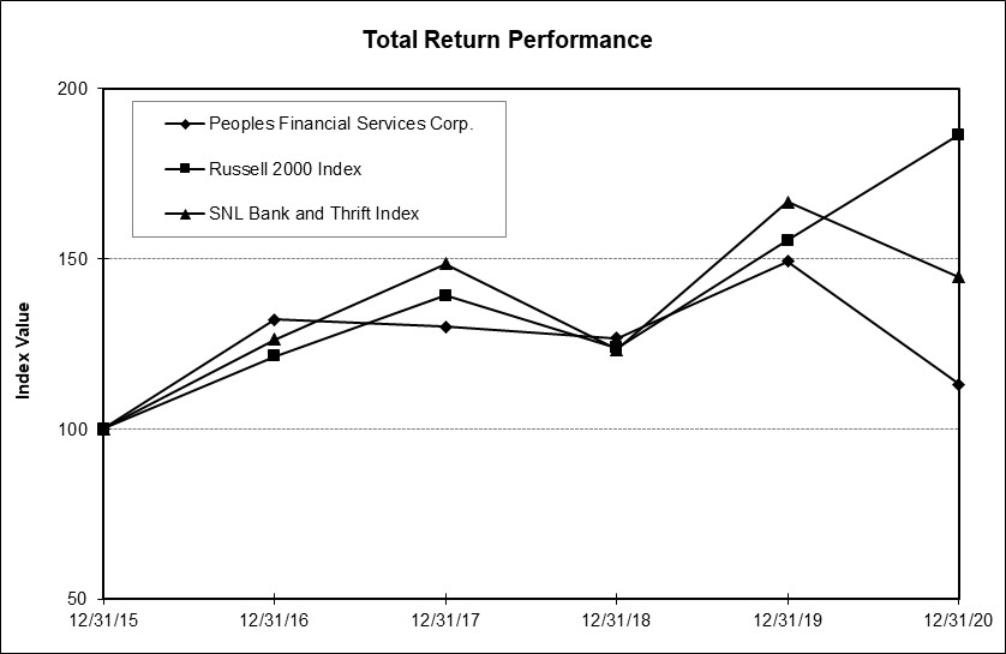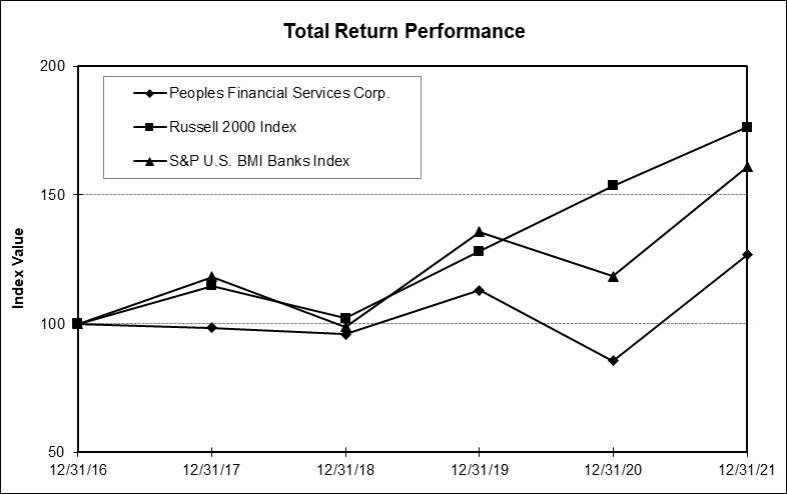The Marcellus Shale formation located in the heart of our northernlegacy market area has provided economic benefits to the communities served and as a result to us. Natural gas producers have invested billions of dollars in Pennsylvania in lease and land acquisition, new well drilling, infrastructure development and community partnerships.
COVID-19
As theOperationally, as COVID-19 events continue to unfold, our continued priority is the health and safety of our employeescustomers and customers. Our management team continuesemployees. We continue to implement its pandemic plan by modifying and enhancing strategies and protocols intended to protect our workforce and customers, maintain services for customers, assure the functional continuity of our operating systems, controls and processes, and mitigate financial risks posed by changing market conditions. We have followedfollow the recommendations of our state governments as to conducting business and continue to maintain safety protocols. Currently all our offices have returned to pre-pandemic operating hours with full lobby access.
On March 22, 2020, the federal banking agencies issued an “Interagency Statement on Loan Modifications and Reporting for Financial Institutions Working with Customers Affected by imposing business travel restrictions, implementing quarantine and work from home protocols and physically separating,the Coronavirus.” The guidance explained that in consultation with the Financial Accounting Standards Board (“FASB”) staff the federal banking agencies concluded that short-term modifications (e.g. six months) made on a good faith basis to the extent possible, the critical operations site workforce that are unable to work remotely. As of March 1, 2021, we have re-opened the majority of our branch lobbies to the public with safety protocols in place. Our remaining branches are operating with drive-up services, with lobby access available by appointment only. We have also maintained active communications with our primary regulatory agencies and critical vendors in an effort to keep all mission-critical activities and functions performing in line with regulatory expectations and the Company’s service standards.
The impactborrowers who were current as of the COVID-19 pandemic is fluid and continues to evolve, adversely affecting manyimplementation date of the Bank’s clients.a modification are not Troubled Debt Restructurings (“TDRs”). The COVID-19 pandemic and its associated impacts on trade (including supply chains), travel, employee productivity, unemployment, consumer spending, and other economic activities have resulted in less economic activity and significant volatility and disruption in financial markets, and has had an adverse effect on our business, financial condition and results of operations. The ultimate extent of the impact of the COVID-19 pandemic on our business, financial condition and results of operations is currently uncertain and will depend on various developments and other factors, including, among others, the duration and scope of the pandemic, as well as governmental, regulatory and private sector responses to the pandemic, and the associated impacts on the economy, financial markets and our customers, employees and vendors. Our business, financial condition and results of operations generally rely upon the ability of our borrowers to repay their loans, the value of collateral underlying our secured loans, and demand for loans and other products and services we offer, which are highly dependent on the business environment in our primary markets where we operate and in the United States generally.
We have participated as a lender in the Coronavirus Aid, Relief and Economic Security (“CARES”) Act ("was passed by Congress on March 27, 2020. Section 4013 of the CARES Act"Act also addressed COVID-19 related modifications and specified that COVID-19 related modifications on loans that were not more than 30 days past due as of December 31, 2019 are not TDRs. On December 27, 2020, another COVID-19 relief bill was signed that extended this guidance until the earlier of January 1, 2022 or 60 days after the date on which the national emergency declared as a result of COVID-19 is terminated. During 2020, the Bank had applied this guidance and modified 479 commercial loans with an outstanding balance of $306.8 million and 512 consumer loans with an outstanding balance of $23.3 million. As of December 31, 2021, all of these modifications had expired and the loans returned to their contractual payment terms.
The CARES Act, as amended, included an allocation of $659 billion for loans to be issued by financial institutions through the Small Business Administration (“SBA”), Paycheck Protection Program (“PPP”). PPP loans are forgivable, in whole or in part, if the proceeds are used for payroll and other permitted purposes in accordance with the requirements of the PPP. These loans carry a fixed rate of 1.00% and a term of two years (loans made before June 5, 2020) or five years (loans made on or after June 5, 2020), a $350 billion specialized low-interest loan program funded byif not forgiven, in whole or in part. Payments are deferred until either the U.S. Treasury Department and administered by the U.S. Small Business Administration (“SBA”). The PPP provides borrower guarantees for lenders, as well as loan forgiveness incentives for borrowers that utilizedate on which the SBA loanremits the amount of forgiveness proceeds to cover employee compensation related business operating costs. Our loan officers guided our commercial customers through the application process and now are guiding them throughlender or the date that is 10 months after the last day of the covered period if the borrower does not apply for forgiveness process andwithin that 10 month period. Through December 31, 2020, the second round of PPP. During 2020, we approvedBank had originated 1,450 PPP loans totaling $217.5 million in principal, with an average loan size of $150,000. The PPP loans originated during 2020 generated net fees totaling $5.2 million. Substantially allThese fees are deferred and accreted into interest income over the contractual period of 24 months or 60 months, as applicable. Upon SBA forgiveness, unamortized fees are then recognized into interest income. Participation in the PPP had a significant impact on the Bank’s asset mix and net interest income in 2021 and 2020 and will continue to impact both asset mix and net interest income until these loans are forgiven or paid off. The initial PPP expired on August 8, 2020. Through December 31, 2020, PPP loans totaling $27.8 million had been forgiven by the SBA and a total of $2.3 million in PPP net fees had been recognized by the Bank.
On December 27, 2020, another COVID-19 relief bill was signed that extended and modified several provisions of the PPP. This included an additional allocation of $284 billion. The SBA reactivated the PPP on January 11, 2021. The Bank originated additional loans were made to existing customers, funded underthrough the two year PPP, loan program,which expired on May 31, 2021. During 2021, the Bank had generated and the loan proceeds initially were deposited with our institution. At origination, loan fee income totaled $7.0received SBA approval on 1,062 PPP loans totaling $121.6 million and is being earned primarily over the 24-month duration of the loans as a part of the loan yield.generated $4.3 million in related deferred PPP loan forgiveness commenced during the fourth quarter of 2020 with $27.8 million of forgiveness being received by our borrowers. We expect the majority of the remaining $189.7 million ofnet fees. During 2021, PPP loans to betotaling $244.3 million had been forgiven during 2021.by the SBA and a total of $7.1 million in PPP net fees and interest income had been recognized by the Bank including fees recognized upon forgiveness and continuing amortization of fees from the 2020 and 2021 PPP originations. At December 31, 2020, $4.0 million of fees remain to be earned in future periods and may be accelerated based on the timing of forgiveness of2021, PPP loans by the SBA. In addition, the Company is participating in the 2021 second round of PPP lending and has received approval by the SBA on 605 applications totaling $80.7 million. The loans closed during January and February.
From a credit risk perspective, we took actions to identify and assess our COVID-19 related credit exposures based on asset class and borrower type. From the onset of the crisis, we worked to proactively monitor our loan portfolio by contacting many of our borrowers to evaluate the impact of the pandemic on them, their businesses and the underlying collateral for our loans. The Company implemented a customer payment deferral program to assist both consumer and business borrowers that may be experiencing financial hardship due to COVID-19 related challenges. For borrowers who received a loan payment deferral we worked with the borrowers to evaluate the potential for further deterioration of

